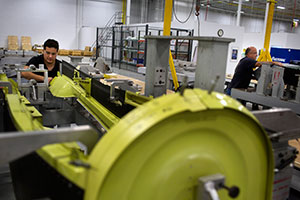Orders for Capital Goods Decline, Signaling Global Growth Slowdown

Orders for business equipment unexpectedly fell in December for a fourth month, signaling a global growth slowdown is weighing on American companies.
Bookings for non-military capital goods excluding aircraft dropped 0.6% for a second month, data from the Commerce Department showed Jan. 27 in Washington. Demand for all durable goods — items meant to last at least three years — declined 3.4 %, the worst performance since August.
Slackening demand from Europe and some emerging markets is probably weighing on orders, making companies less willing to invest in new equipment. At the same time, brightening American consumer attitudes are leading to gains in purchases of big-ticket items such as automobiles and appliances that can ripple through the economy and underpin manufacturing.
“It’s a broad-range weakness,” said Scott Brown, chief economist at Raymond James & Associates Inc. in St. Petersburg, Florida, who is the second-best forecaster of capital goods orders for the past two years, according to data compiled by Bloomberg. “It likely reflects some of the weakness in some other parts of the world.”
Bookings dropped last month for machinery, computers and commercial aircraft, Tuesday’s report showed. Demand for automobiles was one of the few bright spots.
The December figures mark the longest streak of declines in orders for non-military capital goods excluding aircraft since the seven months ending in September 2012.
Excluding transportation equipment, which is often volatile from month to month, bookings decreased 0.8%, the data showed. Demand for non-defense goods fell 3.2%.
The median forecast of 80 economists surveyed by Bloomberg estimated total durable goods orders would rise 0.3%, with projections ranging from a 3.5% drop to a 2% gain. Orders for non-defense capital equipment excluding aircraft were projected to rise 0.9%.
Shipments of non-military capital goods excluding aircraft, used in calculating gross domestic product, decreased 0.2% in December after falling 0.6% the prior month.
This morning’s data are the latest hint at the trend in business investment before fourth-quarter gross domestic product figures are released Jan. 30 from the Commerce Department.
Spending on industrial equipment showed the largest two-quarter annualized gain between April and September since the second half of 2011, and the second-largest since the end of 1964, according to Commerce Department data.
The faltering demand has companies such as Deere & Co., the largest manufacturer of agricultural machinery, preparing to let go staff in Iowa and Illinois as the outlook for global orders weakens. The Moline, Illinois-based company plans to dismiss about 910 workers, according to a statement issued last week.
Falling oil and copper prices are weighing on Caterpillar Inc. The world’s largest mining equipment maker this morning announced earnings in 2015 probably will be $4.75 a share excluding restructuring costs, compared with the average Bloomberg survey estimate of $6.69. Revenue for the Peoria, Illinois-based company this year will be about $50 billion, short of the $55.2 billion survey estimate.
At the same time, some assembly lines still are humming with demand for automobiles hovering at post-recession highs. Cars and light trucks sold at a 16.8 million annualized pace in December, making last year’s 16.4 million monthly average the best annual performance since 2006, according to figures from Ward’s Automotive Group.
The report showed orders for motor vehicles and parts climbed 2.7% after a 0.4% gain a month earlier.
A sustained drop in fuel prices and steady job gains also are providing a cushion for households and propelling demand.
The cost of a gallon of regular gasoline dropped to $2.03 on Jan. 25, the lowest since March 2009, according to data from auto group AAA.
That will help drive consumer spending and the economy, said Raymond James’ Brown.
“You really haven’t seen the domestic economic strength being reflected yet,’ Brown said. “We’re going to see better consumer spending numbers in the first half of this year. That should be more than enough to offset the weakness we’re seeing elsewhere in the world.”
Also bolstering the consumer is a labor market coming off its best year since 1999. Almost 3 million jobs were added in 2014 as the jobless rate declined to 5.6%, a more than six-year low.
GDP data to be released this week will show whether the consumer spending gains were enough to keep the economy growing at a better-than-average post-recession rate even as global demand wanes.
The U.S. economy expanded 3% in the last three months of 2014 after a 5% increase in the third quarter, according to Bloomberg survey estimates. Growth rates have averaged a 2.3% pace in the economic expansion than began in June 2009.

